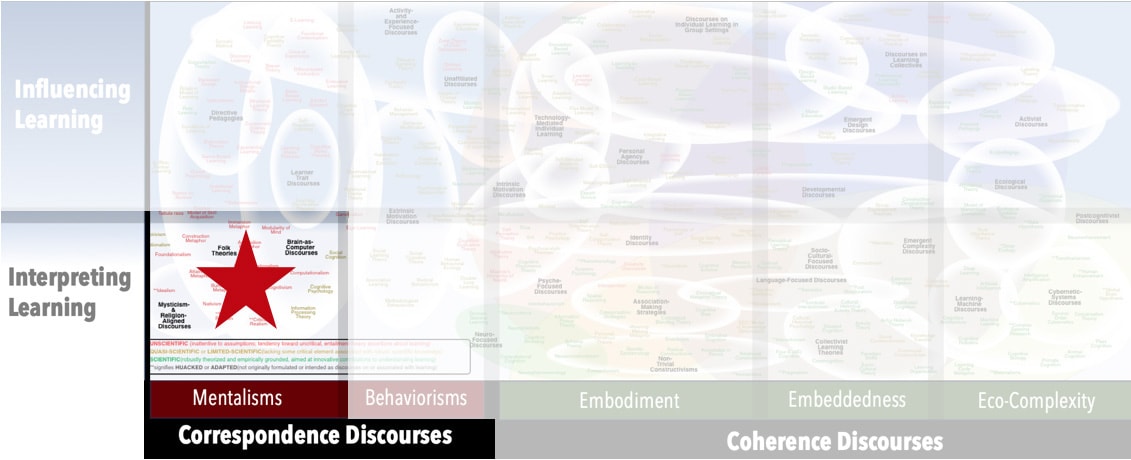AKA
Cognitive Theory
Focus
Drawing an analogy between human cognition and computer functioningPrincipal Metaphors
- Knowledge is … information
- Knowing is … using information
- Learner is … an information processor (individual)
- Learning is … inputting (and associated computer-based notions, such as processing, storing, and retrieving)
- Teaching is … transmission (of information)
Originated
1950sSynopsis
Cognitivism is explicitly developed around the metaphor “brain as computer.” It was prompted by two major happenings. Firstly, some researchers began to push back against Behaviorisms’ deliberate ignorance of mental processes. Secondly, electronic computers appeared on the scene, providing a new cluster of metaphors that seemed well fitted to matters of learning. Cognitivism thus focuses on how information is acquired, processed, and organized. Learning is seen in terms of integration of new information into existing structures through processes of internal codification. While triggered by the computer-revolution in the mid-1900s, prior developments that contributed to Cognitivism’s assumptions on human thought and brain function include:- Aristotle’s Logic (Syllogism; Greek συλλογισμός, “conclusion, inference”) – a form of logical argument that combines two or more accepted propositions to deduce a further truth
- Laws of Thought (George Boole, 1850s) – an attempt “to go under, over, and beyond Aristotle” through fined-grained, mathematical analysis of logical argumentation, which set the stage for the development of Boolean Algebra
- Boolean Algebra (initiated by George Boole in the 1840s, but coherently developed in the early 1900s) – a system of formal logic that enables digital technologies, based on rules of combining values of 1 and 0 (interpreted as, true-or-false or on-or-off)
- Control of Action Model (Attentional Control of Action; Norman and Shallice Model) (Donald Norman, Timothy Shallice, 1980s) – a Cognitivism that locates control in two processes: (1) “Contention Scheduling System,” which automatically regulates routine functions; and (2) “Supervisory Attentional System,” which is engaged for nonroutine events associated with Executive Functions (see Cognitive Processes)
- Spatial Cognition (Edward Tolman, 1940s) – the organization and use of information collected about the structure of the real world, used to manage movement through and manipulation of the real world
- Cognitive Map (Edward Tolman, 1950s) – as it sounds, an internal mapping of the real world, developed by observing and exploring that world. The phrase is sometimes used to refer to goal-directed plans of action.
- Mental Map – a popular notion that, essentially, elaborates the notion of Cognitive Map to include consideration of emotional weights and personal meanings of map elements
- Environmental Cognition (Gary Evans, 1980s) – processing of information in/of the real world, including with regard to memory, location, and navigation
Commentary
Cognitivism is closely aligned with the Acquisition Metaphor, replacing that latter’s “knowledge as object” with “knowledge as information.” Behind both is an assumption that knowledge is something “out there,” independent of the knower, and learning is a process of moving it from the outside to the inside. Cognitivism is thus subject to the same cluster of criticisms as the Acquisition Metaphor. As well, as somewhat ironically, Cognitivism shares many uninterrogated and foundational assumptions with Behaviorisms and other Correspondence Discourses, such as dichotomization of inner and outer and an assumption that learning obeys Newtonian dynamics. Notably, recent decades of research in Cognitive Science have highlighted that Cognitivism’s foundational metaphor, “brain as computer,” is simply wrong.Authors and/or Prominent Influences
Warren McCulloch Walter Pitts (It is difficult to identify seminal thinkers for Cognitivism because the perspective was little more than a repackaging of the Acquisition Metaphor – that is, a re-articulation of one of the most popular Folk Theories in a form that seemed progressive, owing to the newness of electronic-computer technology.)Status as a Theory of Learning
Cognitivism is a theory of learning. However, it a Folk Theory.Status as a Theory of Teaching
As just mentioned, many popular principles of learning have been embraced within Cognitivism. These include suggestions that learners should be made active participants and that educators should pay special attention to learning environments. That said, the core advice for teaching out of Cognitivism is focused on details such as coding, transforming, rehearsing, storing, and retrieving information – that is, the same sorts of emphases that arise in models of teaching associated with the Acquisition Metaphor and many other Folk Theories, albeit with modest rewordings.Status as a Scientific Theory
While Cognitivism is explicit about its orienting metaphor (i.e., “brain as computer”), no substantial research program has emerged to demonstrate the validity of utility of that metaphor. Advocates of Cognitivism have invoked many principles that are consistent with current Cognitive Science (e.g., attending to the role of context; ensuring learners are active and engaged). However, for the most part, such elements are neither anticipated nor supported by the actual theory. Rather, they appear to be prompted by other perspectives – that is, incorporated not because they are integral to the theory, but because they are widely accepted.Subdiscourses:
- Aristotle’s Logic (Syllogism)
- Boolean Algebra
- Cognitive Map
- Control of Action Model (Attentional Control of Action; Norman and Shallice Model)
- Environmental Cognition
- Laws of Thought
- Mental Map
- Spatial Cognition
Map Location

Please cite this article as:
Davis, B., & Francis, K. (2023). “Cognitivism” in Discourses on Learning in Education. https://learningdiscourses.com.
⇦ Back to Map
⇦ Back to List
